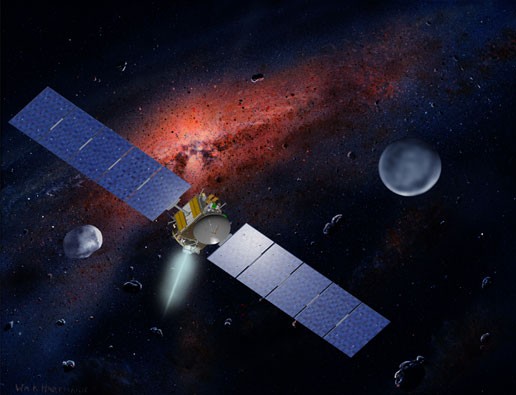NASA's Dawn Spacecraft Approaches Water Planet Ceres
| Ana Verayo | | Jan 01, 2015 06:14 AM EST |
(Photo : NASA/William K. Hartmann Courtesy of UCLA ) Artist concept showing the Dawn spacecraft with Ceres and Vesta in the background.
NASA's Dawn spacecraft is fast closing on the mystery dwarf planet Ceres that might have sub-surface oceans.
Dawn explored the protoplanet Vesta just a few years ago. When it enters Ceres' orbit, Dawn will be the first spacecraft to explore two planetary bodies.
Dawn is the first spacecraft deployed to visit Ceres, a dwarf planet scientists still know little about. When Dawn began its approach to Ceres, it first spent some time on the opposite side of the Sun, which limited communications with the probe. Now, NASA mission control is able to transmit commands to the spacecraft and maneuver it towards the dwarf planet.
Like Us on Facebook
To date, Dawn is 400,000 miles from Ceres and is approaching the dwarf planet at 450 miles per hour. Its path will mean it will rendezvous with Ceres in March 2015.
Ceres is the largest object found in the asteroid belt that divides Mars and Jupiter. Scientists believe it consists of ice and rock and could even have oceans under its surface layer similar to one of Jupiter's moons, Europa.
Ceres is 950 km in diameter and probably has a surface of water-ice. Its100 kilometer-thick mantle contains 200 million cubic kilometers of water, which is more than all the fresh water on Earth.
In January 2014, the Herschel Space Observatory detected water vapor emissions coming from the surface of Ceres.
With the help of Dawn, scientists stand to unravel more mysteries about the strange dwarf planet. Ceres is still quite a complete mystery to the team and unlike Vesta, Ceres apparently has no meteorites that can lead to clues about it, said Christopher Russell, who is the principal investigator for the Dawn mission.
During 2011 and 2012, Dawn explored the protoplanet Vesta for 14 months. Data and images showed scientists the first glimpse of Vesta's surface. A geologic map of Vesta reveals large meteorite impacts during Vesta's early evolution.
This mapping is important in further understanding Vesta's geological history using Dawn's visible and infrared mapping spectrometer and the gamma-ray and neutron detector, according to Carol Raymond, Dawn's deputy principal investigator from NASA's Jet Propulsion Laboratory.
Vesta and Ceres are pivotal in discovering how the solar system was formed since it's possible these large bodies can also contain the building blocks of life and can also provide clues about how life came to be on Earth.
TagsNASA's Dawn Spacecraft Approaches Mysterious Dwarf Planet Ceres, NASA, NASA Dawn spacecraft, ceres planet, vesta planet, NASA Dawn ceres dwarf planet
©2015 Chinatopix All rights reserved. Do not reproduce without permission
EDITOR'S PICKS
-

Did the Trump administration just announce plans for a trade war with ‘hostile’ China and Russia?
-

US Senate passes Taiwan travel bill slammed by China
-

As Yan Sihong’s family grieves, here are other Chinese students who went missing abroad. Some have never been found
-

Beijing blasts Western critics who ‘smear China’ with the term sharp power
-

China Envoy Seeks to Defuse Tensions With U.S. as a Trade War Brews
-

Singapore's Deputy PM Provides Bitcoin Vote of Confidence Amid China's Blanket Bans
-

China warns investors over risks in overseas virtual currency trading
-

Chinese government most trustworthy: survey
-

Kashima Antlers On Course For Back-To-Back Titles
MOST POPULAR
LATEST NEWS
Zhou Yongkang: China's Former Security Chief Sentenced to Life in Prison

China's former Chief of the Ministry of Public Security, Zhou Yongkang, has been given a life sentence after he was found guilty of abusing his office, bribery and deliberately ... Full Article
TRENDING STORY

China Pork Prices Expected to Stabilize As The Supplies Recover

Elephone P9000 Smartphone is now on Sale on Amazon India

There's a Big Chance Cliffhangers Won't Still Be Resolved When Grey's Anatomy Season 13 Returns

Supreme Court Ruled on Samsung vs Apple Dispute for Patent Infringement

Microsoft Surface Pro 5 Rumors and Release Date: What is the Latest?










